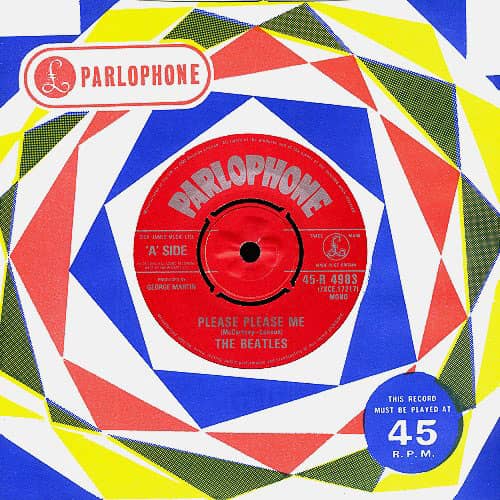Releasing The Beatles debut single
EMI released The Beatles’ debut single, Love Me Do, on October 5, 1962, with Love Me Do on Side A and P.S. I Love You on Side B. At the time, The Beatles were still relatively unknown outside Liverpool and Hamburg, writing songs without the weight of expectation or stardom. EMI originally released the 45 RPM 7″ single without a picture sleeve. 1
On October 27 the band did their first radio interview 2 with Radio Clatterbridge. They discuss music they released in Germany prior to signing to Parlophone. When asked about their new single, Paul explained:
We’ve written over about a hundred songs but we don’t use half of them, you know. We just happened to sort of rearrange Love Me Do and played it to the recording people, and PS I Love You, and uh, they seemed to quite like it. So that’s what we recorded.
Both songs were Lennon–McCartney originals, a bold departure from the industry norm of launching new acts with proven covers. Love Me Do didn’t immediately climb the charts, but its performance hinted at the momentum building behind the band. It reached #17 on the UK charts by December, laying just enough groundwork for what would soon become Beatlemania.
Three drummers in three sessions
What makes this debut particularly fascinating is the behind-the-scenes shuffle. Three different versions of Love Me Dow were recorded at EMI Studio 2 over three recording sessions, each with a different drummer. The first was cut on June 6 with Pete Best, a slower, tentative version that was quickly shelved. By their September 4 session, Ringo Starr had joined the band, and his version was the one chosen for the single release. But George Martin remained uncertain and brought in studio drummer Andy White for a third session a week later on September 11. Ringo, to his credit, shifted to tambourine for that take.
Choosing Ringo’s version over the more polished Andy White take says a lot. It shows The Beatles already had a sense of feel over form, and it marks Ringo’s true arrival. His willingness to serve the song, whether on drums or tambourine, was emblematic of the chemistry that would define the band’s recordings going forward.
George Martin’s original plan was to release Mitch Murray’s How Do You Do It, but this changed during the June 6 recording session when Lennon informed Martin that they wanted to record their own material. Read about this in our article Superimposition: How Do You Do It?
A-Side: Love Me Do – 2:23
- Writers: Lennon–McCartney
- Lead Vocal & Bass: Paul McCartney
- Harmonica & Backing Vocal: John Lennon
- Rhythm Guitar: George Harrison
- Drums: Ringo Starr
- Recording Date: September 4, 1962 – EMI Studio Two
- Producer: George Martin
- Engineer: Norman Smith 3
- Mix Date: September 4, 1962 (mono) 4
- Tape Format: Recorded on EMI BTR-2, a full-track mono recorder
- Key Feature: This version has no tambourine and features Ringo on drums
- Release: Used on the original October 5, 1962 pressing only
B-Side: P.S. I Love You – 2:04
- Lead Vocal & Bass: Paul McCartney
- Backing Vocals & Guitar: John Lennon & George Harrison
- Bongos: Andy White
- Maracas: Ringo Starr
- Recording Date: September 11, 1962 – EMI Studio Two
- Producer: Ron Richards 5 (George Martin was absent)
- Mix Date: September 11, 1962 (mono) 6
- Key Feature: Latin-flavored rhythm with no drum kit
Release & Chart Performance
- Release Date: October 5, 1962 (UK)
- Label: Parlophone R4949
- Publishing: Ardmore & Beechwood (EMI)
- UK Chart Peak: #17 in late December 1962
- US Chart Peak: #1 on Billboard (Tollie reissue, 1964)
Mark Lewisohn notes this interesting bit of history in The Beatles Recording Sessions:
The 250 advance copies of ‘Love Me Do’ made for radio stations and the press carried a mis-spelling, corrected before regular copies were made, showing McArtney instead of McCartney.
Rumors persist that Brian Epstein purchased 10,000 of copies to boost sales. Though Epstein denied it, Beatles insiders later admitted that some manipulation likely occurred. 7
The Beatles Love Me Do Mix Variants and Pressings
Three versions of Love Me Do exist:
- The June 6, 1962 “slow version”, recorded during the band’s artist test with Pete Best on drums. This early take was slower in tempo, raw in execution, and ultimately rejected by George Martin. It remained unreleased until Anthology 1. 8
- The September 4, 1962 version, featuring Ringo Starr on drums — the one issued on the original single.
- The September 11, 1962 version, featuring Andy White on drums and Ringo on tambourine. This is the version used on most later pressings and LPs.
Additional Notes
- The Andy White version was mixed to mono for future use on LPs.
- Fake stereo mixes (electronically reprocessed mono) were created on Feb 25, 1963 9 for Please Please Me by splitting frequency bands and adding EQ separation or reverb delay to simulate stereo spread, a common EMI technique used when no true stereo tape existed. 10
- The original Ringo version’s master tape was no preserved, likely due to EMI’s wipe and remove practices at the time. After a song was completed, engineers would demagnetize and reuse the tapes. 11 This included Master tapes. As a result, original pressings of this version are highly collectible.
Sound & Performance Notes
- Ringo’s version has a more relaxed, raw feel, with his fills lending a unique charm.
- Andy White’s version is tighter and more polished; the tambourine drives the backbeat.
- John couldn’t sing while playing the harmonica so Paul’s vocal was brought forward unexpectedly. Bruce Channel’s Hey! Baby inspired the harmonica line.
- Paul McCartney began writing Love Me Do when he was fifteen years old.12
Historical Significance
- This is the only Beatles single with two songs not produced by George Martin.
- Paul later reacquired the publishing rights to The Beatles Love Me Do and P.S. I Love You, now managed under MPL Communications, the umbrella company for his business interests, established in 1969.
- Both tracks have entered the public domain in Europe under the 50-year copyright rule.
Related Notes
To read about the recording sessions, including instruments and recording gear used to record The Beatles Love Me Do and P.S. I Love You, see our related articles:
- 6 June 1962 Session Note (Artist Test)
- 4 September 1962 Session Note (Recording Session)
- 11 September 1962 Session Note (Recording Session)
- Superimposition: How Do You Do It? (further details 4 September 1962)
- Working Within Constraints (further details 11 September 1962)
- About The Beatles ↩︎
- The Beatles Bible: The Beatles First Interview ↩︎
- The Paul McCartney Project ↩︎
- Mark Lewisohn, The Complete Beatles Recording Sessions (Hamlyn, 2004) ↩︎
- The Paul McCartney Project ↩︎
- Lewisohn, The Complete Beatles Recording Sessions ↩︎
- The Beatles Bible ↩︎
- Mark Lewisohn, Tune In: The Beatles: All These Years, (Crown, 2016) ↩︎
- Lewisohn, The Complete Beatles Recording Sessions ↩︎
- Lewisohn, The Complete Beatles Recording Sessions ↩︎
- Lewisohn, Tune In: The Beatles: All These Years ↩︎
- In the early chapters, Mark Lewisohn notes in Tune In: The Beatles: All These Years that Paul began sketching out “Love Me Do” as early as 1957, while still a schoolboy. He didn’t complete it until a few years later with input from Lennon. ↩︎


